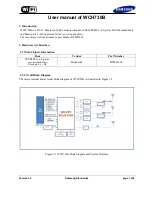
C
OPYRIGHT
&
T
RADEMARKS
Specifications are subject to change without notice. Copyright © 2016 Pepwave Ltd. All Rights Reserved. Pepwave and the
Pepwave logo are trademarks of Pepwave Ltd. Other brands or products mentioned may be trademarks or registered trademarks
of their respective owners.
addresses until it succeeds in making a connection. If the field is empty, your access
point will wait for connection from the remote peer. Therefore, at least one of the two
VPN peers must specify this value. Otherwise, VPN connections cannot be established.
Layer 2 Bridging
When this check box is unchecked, traffic between local and remote networks will be IP
forwarded. To bridge the Ethernet network of an Ethernet port on a local and remote
network, select
Layer 2 Bridging
. When this check box is selected, the two networks
will become a single LAN, and any broadcast (e.g., ARP requests) or multicast traffic
(e.g., Bonjour) will be sent over the VPN.
Management
VLAN ID
This field specifies the VLAN ID that will be tagged to management traffic, such as AP-
to-AP controller communication traffic. A value of 0 indicates that no VLAN tagging will
be applied.
IP Address Mode
Choose
Automatic
or
Manual
. In automatic mode, your access point acquires an IP
from a DHCP server on the Ethernet segment. In manual mode, your access point uses
a user-specified IP address.
IP
Address/Subnet
Mask
When using manual IP addressing (above), enter an IP address and subnet mask in
these fields.
Data Port
This field specifies the outgoing UDP port number for transporting VPN data. If
Default
is selected, port 4500 will be used by default. Port 32015 will be used if port 4500 is
unavailable. If
Custom
is selected, you can input a custom outgoing port number
between 1 and 65535.
8
Tools
8.1 Ping
The ping test tool tests connectivity pinging the specified destination IP address.










































